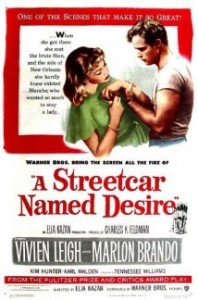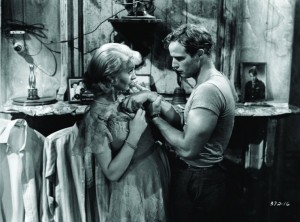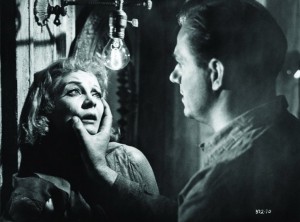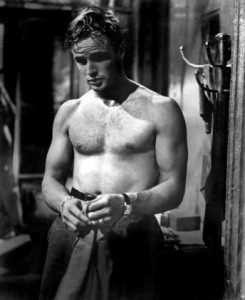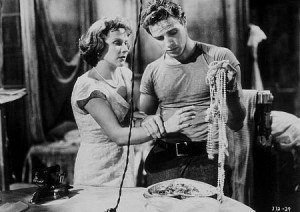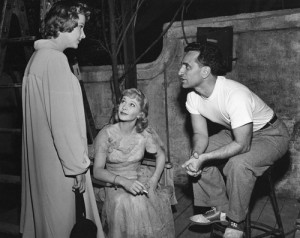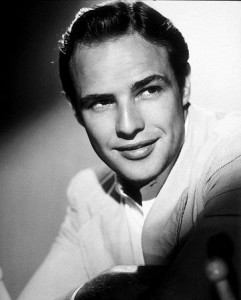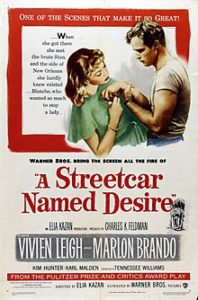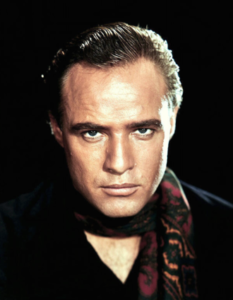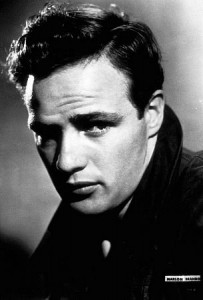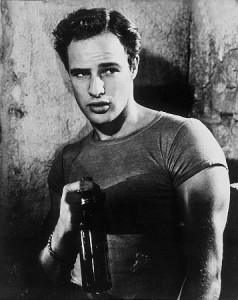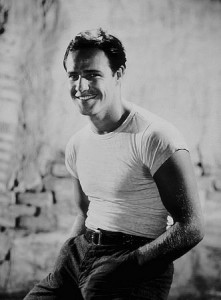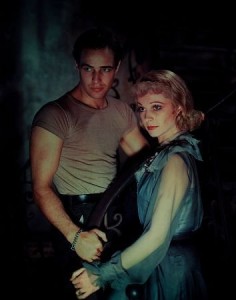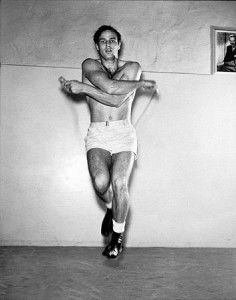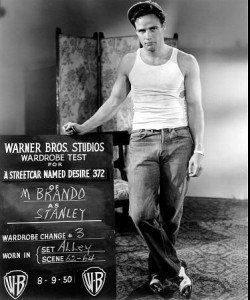A Streetcar Named Desire ***** (1951, Vivien Leigh, Marlon Brando, Kim Hunter, Karl Malden) – Classic Movie Review 974
Director Elia Kazan’s superbly realised 1951 movie version of Tennessee Williams’s greatest and most archetypal play A Streetcar Named Desire is a memorable occasion, lit up by its incandescent performances. It won four Oscars, including Best Actress for Vivien Leigh.
In arguably his greatest achievement, the 27-year-old Marlon Brando sizzles sweatily as the young, heartless Polish stud Stanley Kowalski and the role rocketed him to superstardom. Meanwhile, Vivien Leigh is consumed with an all-enveloping anguish and mental pain, and flails around tragically as his end-of-her-tether, nymphomaniac sister-in-law Blanche DuBois, who always relies on the kindness of strangers.
The film trades heavily on one ace in its hand, the young Brando’s sex appeal. Brando was beefy in those days, but in a sexy kind of way, not the hugely overweight actor struggling with his lines and compelling to improvise that he became in later life. His easy sex appeal is so strong, it’s hard to judge quite how good a performance he’s giving in the actual acting department.
Happily, the film also fully exploits its other winning card, the electric, incandescing power of its star actress. Gone with the Wind apart, Vivien Leigh never did anything as brilliant as this on screen. She is a high-voltage sensation. And Brando and Leigh are a marvellous double act. They really do make weird but sweet music together.
Blanche is a neurotic, frail and faded Mississippi teacher, on the brink of madness, who goes to live with her younger sister Stella (Kim Hunter) in the French quarter of New Orleans. Stella is expecting her first child. But Blanche’s hostile, unrefined pig of a brother-in-law Kowalski determines to force her to leave his home.
Kowalski’s rough and ready buddies come to the house to play cards. One of them, Mitch (Karl Malden), finds Blanche attractive until Stanley tells him what kind of a woman he thinks Blanche is. Stella goes to the hospital to have her baby, leaving Blanche alone with her brother-in-law in the house.
The steamy Southern atmosphere is beautifully captured in Alex North’s jazzy score, Harry Stradling Sr’s black and white cinematography and Richard Day and George James Hopkins’s Oscar-winning black and white art direction/ set decoration.
The Academy also showered Oscars on Leigh, Karl Malden (as her beau Mitch) and Kim Hunter (as her sister), but (in a difficult decision) preferred The African Queen’s Humphrey Bogart to Brando. He must have been mighty disappointed. Perhaps to make amends, The Academy gave him a Best Actor Oscar the following year for his less interesting turn in Viva Zapata! The Oscars are such a frustrating lottery. Who admires or even watches Viva Zapata! now?
Director Kazan masterminds A Streetcar Named Desire as a movie just as he did on stage like an expert showman, but the film’s triumph doesn’t seem about him at all. Everything comes back to the Brando-Leigh match and further back to the unstoppable allure of the brilliant dialogue by Williams, who also wrote his own adapted screenplay. It’s one of America’s greatest plays, and greatest works of literature, and it just happens to suit a film version very nicely.
It was nominated for 12 Oscars and won four. It received Oscar nominations in 12 categories including Best Picture, Best Director and Best Adapted Screenplay, and won for Best Supporting Actor (Malden), Best Supporting Actress (Hunter) and Best Art Direction (Richard Day, George James Hopkins), making it the first film to win in three of the acting categories, a feat later matched by Network in 1976 and Everything Everywhere All at Once in 2022.
The film earned an estimated $4,250,000 at the North American box office in 1951, making it the fifth biggest hit of the year, going on to a total there of $8 million against a budget of $1.8 million.
It was selected in 1999 for preservation in the US National Film Registry by the Library of Congress as being culturally, historically or aesthetically significant.
Ann-Margret’s invigorating 1984 TV version complements this one but doesn’t replace it, and nor does the rousingly performed 1995 Jessica Lange-Alec Baldwin version either.
Nine members of the original Broadway cast (Marlon Brando, Kim Hunter, Karl Malden, Rudy Bond, Nick Dennis, Peg Hillias, Richard Garrick, Ann Dere and Edna Thomas) repeated their roles in the film. Leigh, who replaced Broadway’s Jessica Tandy for the film to add star power, had already played Blanche in the first London production of the play, under the direction of her then-husband, Laurence Olivier. She suffered from bipolar disorder in real life and tragically later had difficulties in distinguishing her life from that of Blanche DuBois.
The cast are Vivien Leigh as Blanche, Marlon Brando as Stanley, Kim Hunter as Stella, Karl Malden as Mitch, Rudy Bond as Steve Hubbell, Peg Hillias as Eunice Hubbell, Nick Dennis as Pablo, Wright King as a collector, Edna Thomas as Mexican Woman, Ann Dere as Matron Nurse, Richard Garrick as Doctor, Lyle Latell as Policeman, and Mickey Kuhn as Sailor.
The A Streetcar Named Desire poster is one of the classic movie posters designed by genius American graphic artist Bill Gold (1921-2018). He was involved in the creation of more than 2,000 posters over eight decades.
Marlon Brando (April 3, 1924 – July 1, 2004) won two Academy Awards, two Golden Globe Awards, one Cannes Film Festival Award, and three British Academy Film Awards in a career spanning six decades.
© Derek Winnert 2014 Classic Movie Review 974
Check out more reviews on http://derekwinnert.com/

